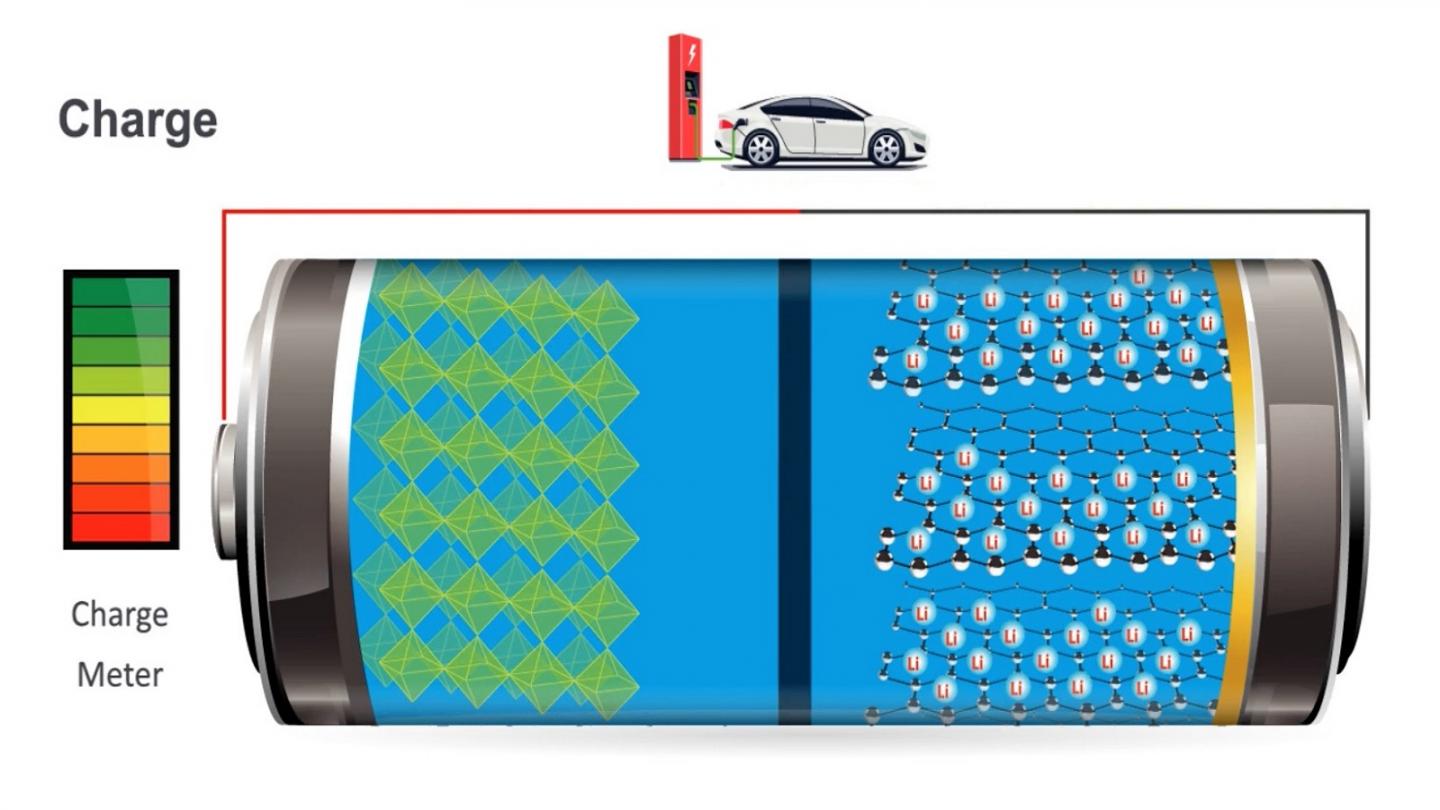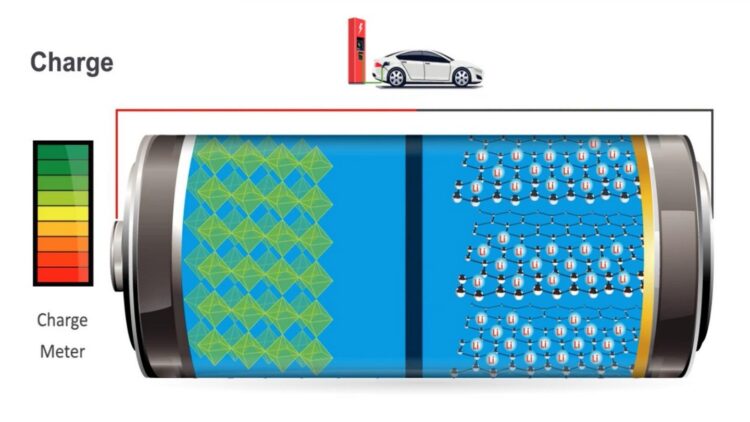
Credit: Department of Energy
The future of mobility is electric cars, trucks and airplanes. But there is no way a single battery design can power that future. Even your cell phone and laptop batteries have different requirements and different designs. The batteries we will need over the next few decades will have to be tailored to their specific uses.
And that means understanding exactly what happens, as precisely as possible, inside each type of battery. Every battery works on the same principle: ions, which are atoms or molecules with an electrical charge, carry a current from the anode to the cathode through material called the electrolyte, and then back again. But their precise movement through that material, whether liquid or solid, has puzzled scientists for decades. Knowing exactly how different types of ions move through different types of electrolytes will help researchers figure out how to affect that movement, to create batteries that charge and discharge in ways most befitting their specific uses.
“We had to connect the dots before, and now we can directly detect the ions. There is no ambiguity.” — Venkat Srinivasan, deputy director, Joint Center for Energy Storage Research, Argonne National Laboratory
In a breakthrough discovery, a team of scientists has demonstrated a combination of techniques that allows for the precise measurement of ions moving through a battery. Using the Advanced Photon Source (APS), a U.S. Department of Energy (DOE) Office of Science User Facility at DOE’s Argonne National Laboratory, these researchers have not only peered inside a battery as it operates, measuring the reactions in real time, but have opened the door to similar experiments with different types of batteries.
The researchers collaborated on this result with the Joint Center for Energy Storage Research (JCESR), a DOE Energy Innovation Hub led by Argonne. The team’s paper, which details velocities of lithium ions moving through a polymer electrolyte, was published in Energy and Environmental Science.
“This is a combination of different experimental methods to measure velocity and concentration, and then compare them both to theory,” said Hans-Georg Steinrück, professor at Paderborn University in Germany and the first author on the paper. “We showed this is possible, and now we will perform it on other systems that are different in nature.”
Those methods, performed at beamline 8-ID-I at the APS, included using ultra-bright X-rays to measure the velocity of the ions moving through the battery, and to simultaneously measure the concentration of ions within the electrolyte, while a model battery discharged. The research team then compared their results with mathematical models. Their result is an extremely accurate figure representing the current carried by ions — what is called the transport number.
The transport number is essentially the amount of current carried by positively charged ions in relation to the overall electric current, and the team’s calculations put that number at approximately 0.2. This conclusion differs from those derived by other methods, researchers said, due to the sensitivity of this new way of measuring ion movement.
The true value transport number has been the subject of some debate among scientists for years, according to Michael Toney, professor at the University of Colorado Boulder and an author on the paper. Toney and Steinrück were both staff scientists at the DOE’s SLAC National Accelerator Laboratory when this research was conducted.
“The traditional way of measuring the transport number is to analyze the current,” Toney said. “But it was unknown how much of that current is due to lithium ions and how much is due to other things you don’t want in your analysis. The principle is easy, but we had to measure accurately. This was certainly a proof of concept.”
For this experiment the research team used a solid polymer electrolyte, instead of the liquid ones in wide use for lithium ion batteries. As Toney notes, polymers are safer, since they avoid the flammability issues of some liquid electrolytes.
Argonne’s Venkat Srinivasan, deputy director of JCESR and an author on the paper, has extensive experience modeling the reactions inside batteries, but this is the first time he’s been able to compare those models to real-time data on the movement of ions through an electrolyte.
“For years we wrote papers about what happens inside a battery, since we couldn’t see the things inside,” he said. “I always joked that whatever I said must be true, since we couldn’t confirm it. So for decades we have been looking for information like this, and it challenges people like me who have been making the predictions.”
In the past, Srinivasan said, the best way to research the inner workings of batteries was to send a current through them and then analyze what happened afterward. The ability to trace the ions moving in real time, he said, offers scientists a chance to change that movement to suit their battery design needs.
“We had to connect the dots before, and now we can directly detect the ions,” he said. “There is no ambiguity.”
Eric Dufresne, physicist with Argonne’s X-ray Science Division, was one of the APS scientists who worked on this project. An author on the paper, Dufresne said the experiment made use of the coherence available at the APS, allowing the research team to capture the effect they were looking for down to velocities of only nanometers per second.
“This is a very thorough and complex study,” he said. “It’s a nice example of combining X-ray techniques in a novel way, and a good step toward developing future applications.”
Dufresne and his colleagues also noted that these experiments will only improve once the APS undergoes an in-progress upgrade of its electron storage ring, which will increase the brightness of the X-rays it produces by up to 500 times.
“The APS Upgrade will allow us to push these dynamic studies to better than microseconds,” Dufresne said. “We will be able to focus the beam for smaller measurements and get through thicker materials. The upgrade will give us unique capabilities, and we will be able to do more experiments of this type.”
That’s a prospect that excites the research team. Steinrück said the next step is to analyze more complex polymers and other materials, and eventually into liquid electrolytes. Toney said he would like to examine ions from other types of material, like calcium and zinc.
Examining a diversity of materials, Srinivasan said, would be important for the eventual goal: batteries that are precisely designed for their individual uses.
“If we want to create high-energy, fast, safe, long-lasting batteries, we need to know more about ion motion,” he said. “We need to understand more about what happens inside a battery, and use that knowledge to design new materials from the bottom up.”
###
This work was supported as part of the Joint Center for Energy Storage Research, an Energy Innovation Hub funded by the U.S. Department of Energy Office of Science, Basic Energy Sciences.
Read the University of Colorado press release.
Read the Universitat Paderborn press release (in German).
The Joint Center for Energy Storage Research (JCESR), a DOE Energy Innovation Hub, is a major partnership that integrates researchers from many disciplines to overcome critical scientific and technical barriers and create new breakthrough energy storage technology. Led by the U.S. Department of Energy’s Argonne National Laboratory, partners include national leaders in science and engineering from academia, the private sector, and national laboratories. Their combined expertise spans the full range of the technology-development pipeline from basic research to prototype development to product engineering to market delivery.
About the Advanced Photon Source
The U. S. Department of Energy Office of Science’s Advanced Photon Source (APS) at Argonne National Laboratory is one of the world’s most productive X-ray light source facilities. The APS provides high-brightness X-ray beams to a diverse community of researchers in materials science, chemistry, condensed matter physics, the life and environmental sciences, and applied research. These X-rays are ideally suited for explorations of materials and biological structures; elemental distribution; chemical, magnetic, electronic states; and a wide range of technologically important engineering systems from batteries to fuel injector sprays, all of which are the foundations of our nation’s economic, technological, and physical well-being. Each year, more than 5,000 researchers use the APS to produce over 2,000 publications detailing impactful discoveries, and solve more vital biological protein structures than users of any other X-ray light source research facility. APS scientists and engineers innovate technology that is at the heart of advancing accelerator and light-source operations. This includes the insertion devices that produce extreme-brightness X-rays prized by researchers, lenses that focus the X-rays down to a few nanometers, instrumentation that maximizes the way the X-rays interact with samples being studied, and software that gathers and manages the massive quantity of data resulting from discovery research at the APS.
This research used resources of the Advanced Photon Source, a U.S. DOE Office of Science User Facility operated for the DOE Office of Science by Argonne National Laboratory under Contract No. DE-AC02-06CH11357.
Argonne National Laboratory seeks solutions to pressing national problems in science and technology. The nation’s first national laboratory, Argonne conducts leading-edge basic and applied scientific research in virtually every scientific discipline. Argonne researchers work closely with researchers from hundreds of companies, universities, and federal, state and municipal agencies to help them solve their specific problems, advance America’s scientific leadership and prepare the nation for a better future. With employees from more than 60 nations, Argonne is managed by UChicago Argonne, LLC for the U.S. Department of Energy’s Office of Science.
The U.S. Department of Energy’s Office of Science is the single largest supporter of basic research in the physical sciences in the United States and is working to address some of the most pressing challenges of our time. For more information, visit https:/
Media Contact
Johnathon Briggs
[email protected]
Original Source
https:/
Related Journal Article
http://dx.





